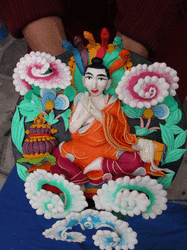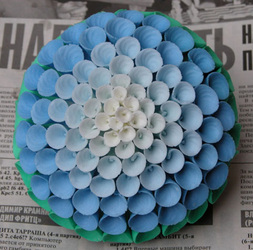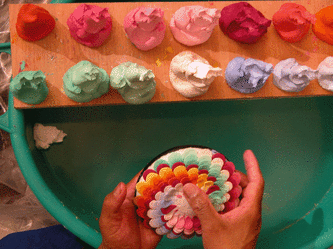Sand Painting
The Sand Mandala (Tibetan: དཀྱིལ་འཁོར།; kilkhor) is a Tibetan Buddhist tradition involving the creation and destruction of mandalas made from colored sand. A sand mandala is ritualistically destroyed once it has been completed and its accompanying ceremonies and viewing are finished to symbolize the Buddhist doctrinal belief in the transitory nature of material life.
Historically, the mandala was not created with natural, dyed sand, but granules of crushed coloured stone. In modern times, plain white stones are ground down and dyed with opaque inks to achieve the same effect. Before laying down the sand, the monks assigned to the project will draw the geometric measurements associated with the mandala. The sand granules are then applied using small tubes, funnels, and scrapers, until t he desired pattern over-top is achieved. Sand mandalas traditionally take several weeks to build, due to the large amount of work involved in laying down the sand in such intricate detail. It is common that a team of monks will work together on the project, creating one section of the diagram at a time, working from the center outwards.
~ wikipedia
Historically, the mandala was not created with natural, dyed sand, but granules of crushed coloured stone. In modern times, plain white stones are ground down and dyed with opaque inks to achieve the same effect. Before laying down the sand, the monks assigned to the project will draw the geometric measurements associated with the mandala. The sand granules are then applied using small tubes, funnels, and scrapers, until t he desired pattern over-top is achieved. Sand mandalas traditionally take several weeks to build, due to the large amount of work involved in laying down the sand in such intricate detail. It is common that a team of monks will work together on the project, creating one section of the diagram at a time, working from the center outwards.
~ wikipedia
Butter Sculpture
Butter sculpture is another Tibetan Buddhist artistic visual impact. The sacred offering is made from mainly butter with other mineral pigments. The size of butter sculptures vary from several centimeters to several meters, tableaux, covering a variety of subjects, including deities, butter mandalas, flowers, animals and Buddhist symbols. Traditionally, butter sculptures are displayed on monastery altars and family shrines as offerings. In the session of the Great Prayer Festival, there will be a butter sculpture display and competition before the Jokhang Temple.
Butter sculptures are created by hand. Since butter melts easily, monk artists making butter sculptures need to work in cold conditions. They have to dip their hands into cold water to cool their fingers down to begin working with the butter. Monks take great pride in their religious creations. A few tools, such as hollow bones for making long threads, and moulds for making leaves and alike, are applied.
The butter sculptures in Ta'er Monastery enjoy the highest reputation in the Tibetan world. The monastery has a butter sculpture museum housing a find collection of butter sculptures.
~www.travelchinaguide.com
Butter sculptures are created by hand. Since butter melts easily, monk artists making butter sculptures need to work in cold conditions. They have to dip their hands into cold water to cool their fingers down to begin working with the butter. Monks take great pride in their religious creations. A few tools, such as hollow bones for making long threads, and moulds for making leaves and alike, are applied.
The butter sculptures in Ta'er Monastery enjoy the highest reputation in the Tibetan world. The monastery has a butter sculpture museum housing a find collection of butter sculptures.
~www.travelchinaguide.com
Thangka Painting
Coming soon...


















